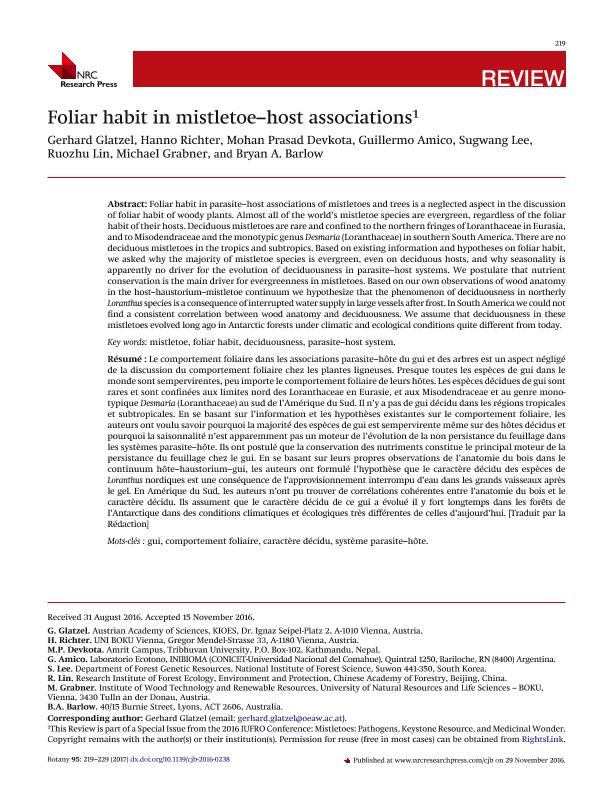Artículo
Foliar habit in mistletoe-host associations
Glatzel, Gerhard; Richter, Hanno; Devkota, Mohan Prasad; Amico, Guillermo Cesar ; Lee, Sugwang; Lin, Ruozhu; Grabner, Michael; Barlow, Bryan A.
; Lee, Sugwang; Lin, Ruozhu; Grabner, Michael; Barlow, Bryan A.
 ; Lee, Sugwang; Lin, Ruozhu; Grabner, Michael; Barlow, Bryan A.
; Lee, Sugwang; Lin, Ruozhu; Grabner, Michael; Barlow, Bryan A.
Fecha de publicación:
03/2017
Editorial:
National Research Council Canada-NRC Research Press
Revista:
Botany
ISSN:
1916-2804
Idioma:
Inglés
Tipo de recurso:
Artículo publicado
Clasificación temática:
Resumen
Foliar habit in parasite-host associations of mistletoes and trees is a neglected aspect in the discussion of foliar habit of woody plants. Almost all of the world’s mistletoe species are evergreen, regardless of the foliar habit of their hosts. Deciduous mistletoes are rare and confined to the northern fringes of Loranthaceae in Eurasia, and to Misodendraceae and the monotypic genus Desmaria (Loranthaceae) in southern South America. There are no deciduous mistletoes in the tropics and subtropics. Based on existing information and hypotheses on foliar habit, we asked why the majority of mistletoe species is evergreen, even on deciduous hosts, and why seasonality is apparently no driver for the evolution of deciduousness in parasite-host systems. We postulate that nutrient conservation is the main driver for evergreenness in mistletoes. Based on our own observations of wood anatomy in the host-haustorium-mistletoe continuum we hypothesize that the phenomenon of deciduousness in northerly Loranthus species is a consequence of interrupted water supply in large vessels after frost. In South Americawecould not find a consistent correlation between wood anatomy and deciduousness. We assume that deciduousness in these mistletoes evolved long ago in Antarctic forests under climatic and ecological conditions quite different from today.
Palabras clave:
Deciduousness
,
Foliar Habit
,
Mistletoe
,
Parasite-Host System
Archivos asociados
Licencia
Identificadores
Colecciones
Articulos(INIBIOMA)
Articulos de INST. DE INVEST.EN BIODIVERSIDAD Y MEDIOAMBIENTE
Articulos de INST. DE INVEST.EN BIODIVERSIDAD Y MEDIOAMBIENTE
Citación
Glatzel, Gerhard; Richter, Hanno; Devkota, Mohan Prasad; Amico, Guillermo Cesar; Lee, Sugwang; et al.; Foliar habit in mistletoe-host associations; National Research Council Canada-NRC Research Press; Botany; 95; 3; 3-2017; 219-229
Compartir
Altmétricas



